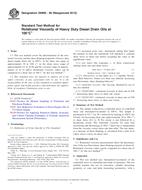We need your consent to use the individual data so that you can see information about your interests, among other things. Click "OK" to give your consent.
ASTM D1159-07(2012)
Standard Test Method for Bromine Numbers of Petroleum Distillates and Commercial Aliphatic Olefins by Electrometric Titration
STANDARD published on 15.4.2012
The information about the standard:
Designation standards: ASTM D1159-07(2012)
Note: WITHDRAWN
Publication date standards: 15.4.2012
SKU: NS-16492
The number of pages: 10
Approximate weight : 30 g (0.07 lbs)
Country: American technical standard
Category: Technical standards ASTM
The category - similar standards:
Petroleum products in generalLubricants, industrial oils and related products
Annotation of standard text ASTM D1159-07(2012) :
Keywords:
aliphatic olefins, bromine number, electrometric titration, petroleum distillates, Gasoline, Hydrocarbons, Kerosine, Aliphatic olefins, Behavior of compounds, Bromine number, Distillate fuels, Electrometric titration, Olefins content, Petroleum distillates, ICS Number Code 75.080 (Petroleum products in general), 75.100 (Lubricants, industrial oils and related products)
Additional information
| Significance and Use | ||||||||||
|
The bromine number is useful as a measure of aliphatic unsaturation in petroleum samples. When used in conjunction with the calculation procedure described in Annex A2, it can be used to estimate the percentage of olefins in petroleum distillates boiling up to approximately 315°C (600°F). The bromine number of commercial aliphatic monoolefins provides supporting evidence of their purity and identity. |
||||||||||
| 1. Scope | ||||||||||
|
1.1 This test method covers the determination of the bromine number of the following materials: 1.1.1 Petroleum distillates that are substantially free of material lighter than isobutane and that have 90 % distillation points (by Test Method D86) under 327°C (626°F). This test method is generally applicable to gasoline (including leaded, unleaded, and oxygenated fuels), kerosine, and distillates in the gas oil range that fall in the following limits:
1.1.2 Commercial olefins that are essentially mixtures of aliphatic mono-olefins and that fall within the range of 95 to 165 bromine number (see Note 1). This test method has been found suitable for such materials as commercial propylene trimer and tetramer, butene dimer, and mixed nonenes, octenes, and heptenes. This test method is not satisfactory for normal alpha-olefins. Note 1—These limits are imposed since the precision of this test method has been determined only up to or within the range of these bromine numbers. 1.2 The magnitude of the bromine number is an indication of the quantity of bromine-reactive constituents, not an identification of constituents; therefore, its application as a measure of olefinic unsaturation should not be undertaken without the study given in Annex A1. 1.3 For petroleum hydrocarbon mixtures of bromine number less than 1.0, a more precise measure for bromine-reactive constituents can be obtained by using Test Method D2710. If the bromine number is less than 0.5, then Test Method D2710 or the comparable bromine index methods for industrial aromatic hydrocarbons, Test Methods D1492 or D5776 must be used in accordance with their respective scopes. The practice of using a factor of 1000 to convert bromine number to bromine index is not applicable for these lower values of bromine number. 1.4 The values stated in SI units are to be regarded as the standard. The values given in parentheses are for information only. 1.5 This standard does not purport to address all of the safety concerns, if any, associated with its use. It is the responsibility of the user of this standard to establish appropriate safety and health practices and determine the applicability of regulatory limitations prior to use. For specific warning statements, see Sections 7, 8, and 9. |
||||||||||
| 2. Referenced Documents | ||||||||||
|
Similar standards:
Historical
1.1.2012
Historical
1.6.2012
Historical
1.1.2014
Historical
1.11.2012
Historical
1.12.2012
Historical
1.1.2011
We recommend:
Technical standards updating
Do you want to make sure you use only the valid technical standards?
We can offer you a solution which will provide you a monthly overview concerning the updating of standards which you use.
Would you like to know more? Look at this page.



 ASTM D6809-02(2012)..
ASTM D6809-02(2012).. ASTM D6822-12b
ASTM D6822-12b ASTM D6892-03(2014)..
ASTM D6892-03(2014).. ASTM D6895-06(2012)..
ASTM D6895-06(2012).. ASTM D7094-12e1
ASTM D7094-12e1 ASTM D7152-11
ASTM D7152-11
 Cookies
Cookies
